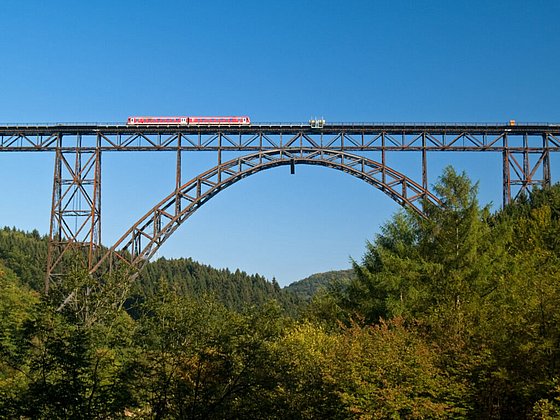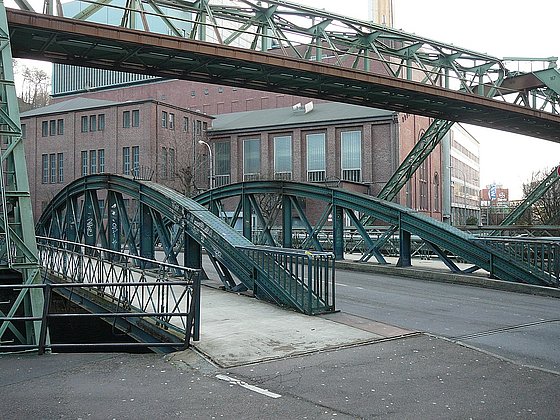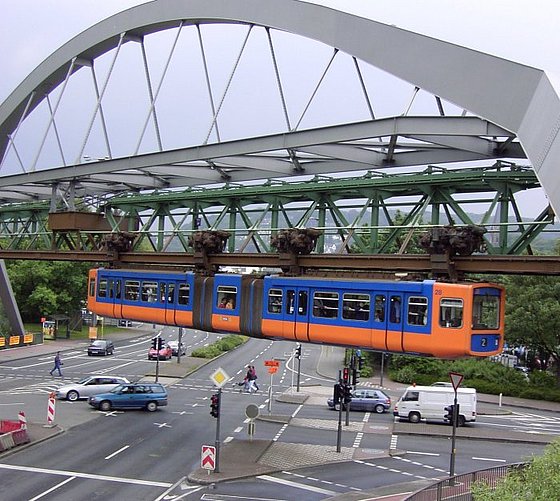
Building with steel
Prof. Dr.-Ing. Bernd Naujoks / Steel and composite structures
Photo: Michael Kaufmann
Building with steel is economical, flexible, durable and... sustainable
Engineer Bernd Naujoks on the advantages of an indispensable building material in the North Rhine-Westphalian industry: steel.
"We have been making remarkable steel constructions here in the region for more than 150 years," says Professor Bernd Naujoks from the Department of Steel Construction and Composite Structures at the University of Wuppertal. Although steel is an expensive material, it is indispensable for some spans, especially in bridge construction. In this context, one inevitably has to talk about the Müngsten Bridge, the steel marvel of the Bergisches Land region, which can certainly compete with the famous structures of the Frenchman Gustave Eiffel, whose 100th anniversary of death has just been commemorated.

Müngsten Bridge
Stephan Kemmerling CCBY-SA 30
Müngsten Bridge
Germany's highest railway bridge, the Müngsten Bridge, was completed between 1895 and 1897 and is still a tourist attraction today. With 5,000 tonnes of steel and 950,000 rivets installed, the arched bridge is also susceptible to repairs, as steel corrodes over time. Depending on the environment, it has to be repaired every 30 years. The bridge was completely sandblasted a few years ago and was given three layers of corrosion protection at a cost of more than 30 million euros. These are complex and, above all, expensive maintenance costs. The experienced engineer sees things differently and says: "It's the other way round, because compared to a new construction, it's a bargain." Of course, you always have to think about the costs, but compared to prestressed concrete bridges, which last just under 50 years and can't perform anywhere near the tasks of steel bridges, the corrosion protection of steel girders is a very sustainable measure. "This is also the trend we are currently experiencing. We are taking better care of our existing buildings, and corrosion protection is simply part of that."

Wupper bridge Kabelstraße
CCB-SA 3.0
Wuppertal's steel bridges
Over 90 bridges line the river Wupper in the city centre. The majority of these bridges are made of metal and steel and were built in the last quarter of the 19th century. Naujoks is not sure whether the 1889 World Exhibition was the initial spark for the Bergisches Land region and says: "In any case, it is quite obvious that we had a lot of metalworking industry here. Of course, this also characterises the landscape and you come across steel as a material much more quickly. They are also very intelligent supporting structures, and there was no reluctance to use this material here at a very early stage."
Exhibition halls unthinkable without steel construction
Even today, steel is an integral part of the construction industry. Naujoks says that it is used in heavy plant construction for industrial buildings as well as in almost all hall constructions. "Long-span hall constructions and exhibition halls would be inconceivable without steel construction," he explains, citing the exhibition halls in Stuttgart as an example. "There are beautiful stadiums and sports arenas with fantastic steel roofs," he reports enthusiastically, but steel also plays its part on a small scale in mundane multi-storey car parks and commercial buildings. He is convinced of the advantages of this globally abundant building material. "Above all, it's the high performance, because we can transfer very high forces in a small space using bolted or welded connections. That's what makes this material so interesting. Despite the sometimes expensive material, we can realise very slim, low-material, lightweight constructions."
Composite steel constructions ... and the vexing issue of fire protection
But composite steel constructions are also obligatory today. "In building construction in Germany," explains the expert, "a multi-storey car park in composite construction is virtually standard." Composite bridges have also proven to be very economical in terms of maintenance costs. Prestressed concrete is still cheap in this country, but at just under 50 years, it has a shorter service life than pure steel structures.
One of the main challenges in the construction industry is the increasingly strict official regulations. This also includes fire protection, as steel quickly loses its strength at high temperatures. Naujoks comments: "There are certainly intelligent fire protection solutions, such as the Düsseldorf city gate. The steel structure is visible. It could have been completely clad, but my former colleague Prof Wolfram Klingsch succeeded in creating a good fire protection concept in this visible structure." However, he questions whether our fire protection measures are still realistic and says: "When I see that some lecture halls here are closed due to fire protection requirements without us ever having had any problems with them, it's certainly something to think about."

Suspension railway
in the public domain
Wuppertal's steel construction as a model
Naujok's workplace is located on the Haspel, virtually right next to Wuppertal's largest steel structure, the suspension railway. Its framework consists of numerous components that were unique and could only be used in this one place. To this day, such constructions have an influence on modern teaching and training of future engineers. "I always mention this in my lectures," he concludes. "If you take a closer look, you will recognise a modular design and a very intelligent load-bearing system, which you don't see at first glance. It centres the loads very cleverly and is still absolutely exemplary today."
Uwe Blass
Prof Dr Bernd Naujoks is Head of the Department of Steel Construction and Composite Structures in the Faculty of Architecture and Civil Engineering at the University of Wuppertal.
